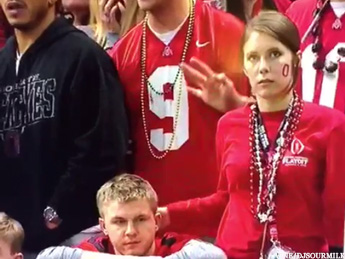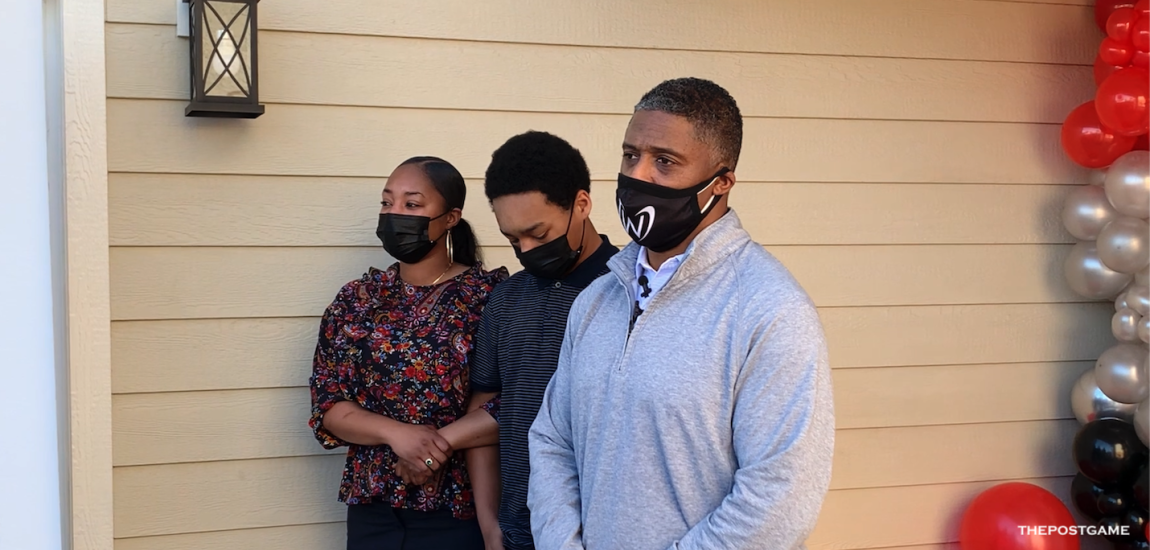For Ohio State fans, Thursday was a night to remember. With the odds and common sense against them, the fourth-ranked Buckeyes upset No. 1 Alabama Crimson Tide, 42-35, in the Sugar Bowl. Ohio State proved its worth in New Orleans and Urban Meyer's team moved on to the National Championship Game.
However, one Buckeye fan may be in need of damage control. With 9:53 left in the fourth quarter and Ohio State up 34-28, one female fan in scarlet was caught stroking the hair of a male fan.
It appears the woman caught herself on the Jumbotron (and ESPN's cameras) and immediately pulled her hand back.
Her eyes and nervous nose pick give the incident some extra drama.
Vine user djsourmilk, who posted the now-viral video, captioned the clip, "When you're at the game with your side dude and realize you're on TV."
Here's another look at the initial reaction:

Somewhere, Katherine Webb and Brent Musburger are chuckling at this clip. As is the infamous couple from this year's Falcons-Bucs game:

Kids, let this be a lesson about live TV. Think before you act.
-- Follow Jeffrey Eisenband on Twitter @JeffEisenband.
Heisman Winners And National Champions

1938 Davey O'Brien, TCU
At 140 pounds, O'Brien was a slender quarterback, but a dominant player. His Heisman-winning season saw him throw for 1,733 yards and 19 touchdowns, and he still holds the college football record for most rushing and passing plays in a season, with 400 under his belt. O'Brien led Texas Christian to an undefeated season in 1941 and a share of the national championship. After college, O'Brien enjoyed a short stint in the NFL before briefly serving as an FBI agent.

1941 Bruce Smith, Minnesota
Bruce Smith received his Heisman Trophy just two days before the attack on Pearl Harbor. At 200 pounds, Smith was a freight train in the 1940s, and he lead Minnesota to undefeated national championships in both 1940 and 1941, the latter being his Heisman-winning season.

1942 Frank Sinkwich, Georgia
A serviceman through and through, Sinkwich wore his Marine uniform to receive his Heisman Trophy. His 1942 campaign was capped by a dominant Orange Bowl performance in which he piled up 382 combined rushing and passing yards -- still an Orange Bowl record. The victory lifted Georgia to a share of the 1942 national championship. (Ohio State was No. 1 in the final AP poll, which in those days was published after the regular season, but didn't play a bowl game.)

1943 Angelo Bertelli, Notre Dame
Before entering the Marines and serving in World War II, Bertelli was an integral part of Notre Dame's famous T-formation offense. Bertelli's quarterback play lifted the Fighting Irish to a scoring average of more than 40 points in his Heisman-winning season. After his college days, Bertelli served on both Iwo Jima and Guam in the Pacific Ocean.

1945 Felix "Doc" Blanchard, Army
One of the fastest men in college football, Blanchard was a three-time All-American who rushed for 1,908 yards and 38 touchdowns over three years at West Point. He won the Heisman Trophy and a national championship in his junior season before entering into active military service.

1946 Glenn Davis, Army
Davis was a prolific offensive star for his entire Army career, accounting for 59 touchdowns and more than 4,100 yards. His Heisman-winning season was also an undefeated run for Army, which claimed a share of national championship that year. (Notre Dame was No. 1 in the AP poll.) Davis served in Korea until 1950 and then resumed his football career with the Los Angeles Rams, winning two championships.

1947 John Lujack, Notre Dame
After Bertelli left Notre Dame, Lujack stepped in as his successor. He was no less prolific than his predecessor: Lujack's greatest moment came when he led the Fighting Irish to a stunning 26-0 victory over then-unbeaten Army. Lujack led Notre Dame to championships in 1946 and 1947, winning the Heisman in his final season.

1949 Leon Hart, Notre Dame
A captain for the 1949 national championship team, Leon Hart was the second lineman to win a Heisman. He played both sides of the ball and received every major award available in 1949. After Notre Dame, Hart joined the Detroit Lions and helped the franchise to three championships.

1976 Tony Dorsett, Pitt
By the time he left Pittsburgh, Tony Dorsett was one of the greatest running backs in college football history. He set a slew of records for rushing at the time, including his 1,948 rushing yards in his Heisman-winning season. Dorsett dominated Heisman voting, beating the runner-up 701-73 in first-place votes, and Pittsburgh rumbled to the 1976 national championship.

1993 Charlie Ward, Florida State
A two-sport star who ultimately opted for an NBA career, Ward was a tremendous pass-run threat under center for Florida State. He led the Seminoles to the 1993 championship with his slippery footwork in the backfield, which allowed him to extend plays and run upfield for an average of six years per attempt.

1996 Danny Wuerffel, Florida
The strong arm behind Steve Spurrier's Fun 'N Gun offense, Wuerffel threw for 3,625 yards, 39 touchdowns and only 13 interceptions. His incredible pass efficiency mark of 170.61 was a big reason Florida went 11-1 and won the national title.

1997 Charles Woodson, Michigan
Though primarily a defensive back, Woodson also contributed as a wide receiver and return man for the Wolverines. His prowess helped Michigan split the 1997 national championship with Nebraska. After college, Woodson became a respected NFL player and is still playing professional ball.

2004 Matt Leinart, USC (later vacated)
Although scandals later vacated several wins, including the BCS Championship game, Leinart was dominant as a junior quarterback, partnering with running back Reggie Bush to lead USC to an undefeated season. Despite a Heisman Trophy and championship ring, Leinart turned down the NFL to return for his senior season.

2009 Mark Ingram, Alabama
Ingram won one of the closest votes in Heisman history, edging out Stanford's Toby Gerhart by just 28 points. He did so by setting Alabama's single-season rushing record with 1,659 yards, along with 334 receiving yards and 20 total touchdowns. Thanks to Ingram's contributions, the Crimson Tide won its first championship under Nick Saban.

2010 Cam Newton, Auburn
A junior-college transfer given the starting QB job at Auburn, Cam Newton didn't disappoint. His dual-threat work as a passer and scorer led Auburn to the national championship game, where it narrowly edged out Oregon. With a Heisman Trophy to boot, Newton bolted for the NFL after the 2010 season.

2013 Jameis Winston, Florida State
In the face of sexual assault accusations, Winston propelled Florida State to a national championship as a redshirt freshman. The conduct accusations didn't abate with a Heisman Trophy and championship ring, however, continuing into the offseason and his sophomore campaign with the Seminoles.
-
Related
 Warrick Dunn's Foundation Helps 200th Single-Parent Family Become First-Time Homeowner
Warrick Dunn's Foundation Helps 200th Single-Parent Family Become First-Time Homeowner -
Related
 'Hard To Beat The Cheaters': Harbaugh, Michigan At College Football Crossroads
'Hard To Beat The Cheaters': Harbaugh, Michigan At College Football Crossroads -
Related
 Landon Collins: I'd Move Out Of The Way Of Saquon Barkley
Landon Collins: I'd Move Out Of The Way Of Saquon Barkley -
Related
 Minkah Fitzpatrick's Work Ethic Was So Insane His Coach Invented A Word For It
Minkah Fitzpatrick's Work Ethic Was So Insane His Coach Invented A Word For It
